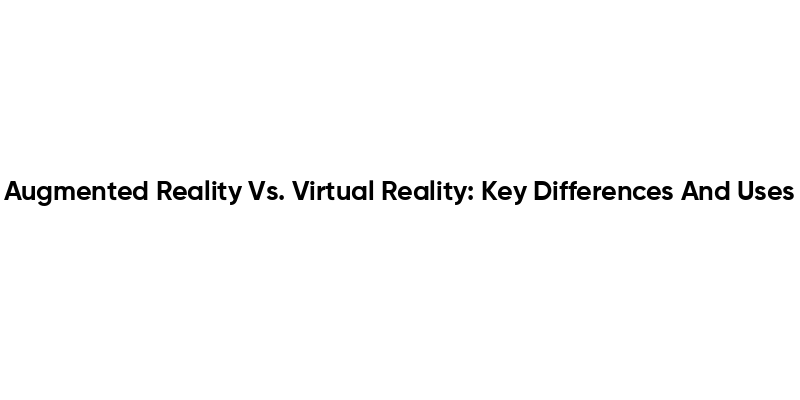In the rapidly evolving landscape of technology, Augmented Reality (AR) and Virtual Reality (VR) have emerged as two groundbreaking innovations that are reshaping our interaction with the digital world. While both technologies offer immersive experiences, they serve distinct purposes and cater to different user needs. This article delves into the key differences and uses of AR and VR, providing insights into how these technologies are being utilized across various sectors, from gaming and entertainment to education and healthcare.
As you read further, you will uncover the fundamental characteristics that set Augmented Reality apart from Virtual Reality. We will explore how AR enhances the real world by overlaying digital information, while VR creates entirely simulated environments. Additionally, we will discuss the practical applications of each technology, highlighting real-world examples that illustrate their impact and potential. Whether you are a tech enthusiast, a business professional, or simply curious about these innovations, this article promises to equip you with valuable knowledge.
Join us on this journey as we dissect the nuances of Augmented Reality and Virtual Reality. By the end of this article, you will not only understand the differences between these two technologies but also appreciate their unique contributions to our daily lives. So, keep reading to discover how AR and VR are transforming industries and what the future holds for these exciting technologies!
Definition and Core Concepts
Augmented Reality (AR) and Virtual Reality (VR) are two distinct technologies that enhance user experiences in different ways. AR overlays digital information onto the real world, allowing users to interact with both physical and virtual elements simultaneously. In contrast, VR immerses users in a completely virtual environment, isolating them from the real world. Understanding these core concepts is essential for grasping their applications and implications in various fields.
The fundamental difference lies in the user experience; AR enhances reality, while VR creates an entirely new one. This distinction leads to varied uses in industries such as gaming, education, healthcare, and more. As technology advances, the lines between AR and VR may blur, but their unique characteristics remain crucial for their respective applications.
Key Technologies Behind AR and VR
The technologies that power AR and VR are pivotal to their functionality. AR typically relies on devices like smartphones, tablets, and AR glasses, utilizing cameras and sensors to detect the environment and overlay digital content. Popular examples include Pokémon GO and Google Lens, which demonstrate how AR can enhance everyday experiences.
On the other hand, VR requires more specialized equipment, such as VR headsets (e.g., Oculus Rift, HTC Vive) that provide immersive experiences through stereoscopic displays and motion tracking. These technologies create a sense of presence in a virtual world, making VR particularly effective for simulations and training scenarios. Understanding these technologies helps users appreciate the capabilities and limitations of each medium.
Applications in Various Industries
Both AR and VR have found applications across numerous industries, each offering unique benefits. In education, AR can bring textbooks to life, allowing students to interact with 3D models and visualizations. This interactive learning approach enhances engagement and retention, making complex subjects more accessible.
Conversely, VR is revolutionizing training in fields like healthcare and aviation. Medical professionals can practice surgeries in a risk-free virtual environment, while pilots can simulate flight scenarios. These applications highlight how AR and VR can improve skills and knowledge retention, ultimately leading to better outcomes in real-world situations.
User Experience and Interaction
The user experience in AR and VR differs significantly, influencing how individuals interact with content. AR users remain aware of their surroundings, allowing for a blend of real and digital interactions. This can lead to more social experiences, as users can share their augmented views with others in real-time.
In contrast, VR users are fully immersed in a virtual environment, which can lead to a more solitary experience. However, advancements in social VR platforms are beginning to change this dynamic, enabling users to interact with others in virtual spaces. Understanding these differences in user experience is crucial for developers and marketers aiming to create engaging content.
Future Trends and Developments
The future of AR and VR is promising, with ongoing advancements in technology and applications. As hardware becomes more affordable and accessible, we can expect wider adoption in everyday life. For instance, AR could become a standard feature in smartphones, enhancing navigation and shopping experiences.
Meanwhile, VR is likely to evolve with improvements in graphics and haptic feedback, making virtual experiences more realistic. The integration of AI and machine learning could also personalize user experiences, tailoring content to individual preferences. Keeping an eye on these trends will be essential for anyone interested in the future of digital interaction.
| Aspect | Augmented Reality (AR) | Virtual Reality (VR) |
|---|---|---|
| Definition | AR overlays digital information onto the real world. | VR creates a completely immersive digital environment. |
| Interaction | Users interact with both real and virtual elements. | Users interact solely within the virtual environment. |
| Technology | Uses devices like smartphones, tablets, and AR glasses. | Requires VR headsets and sometimes additional equipment. |
| Applications | Used in gaming, education, retail, and navigation. | Used in gaming, training simulations, and virtual tours. |
| Experience | Enhances the real world with digital elements. | Immerses users in a fully virtual world. |
| Examples | Pokémon GO, Google Lens, IKEA Place. | Oculus Rift, HTC Vive, PlayStation VR. |
Conclusion
Both Augmented Reality and Virtual Reality offer unique experiences and applications. AR enhances the real world by adding digital elements, making it useful for various industries such as retail and education. In contrast, VR provides a fully immersive experience, ideal for gaming and training simulations. Understanding the key differences and uses of each technology can help in selecting the right one for specific needs.



